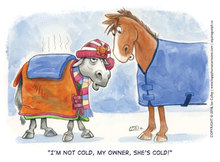Fall is a popular time for horse owners to go blanket shopping but before you dash out to purchase the latest in equine haute couture or the warmest rug with the most fill, consider what your horse really needs.

Getting horse blankets right
Remember- just because you are cold does not mean the horse is cold!.
© 2017 by Ian Culley
Equine Guelph has partnered with internationally renowned blanket manufacturer, Bucas of Ireland to bring you the ‘ThermoRegulator Online Healthcare Tool’.
Strolling into the saddlery for a rug, without an understanding of the factors at play in thermoregulation could result in overheating, dehydration or sickness due to chilling. Depending on your climate, the choice to buy a blanket may mean purchasing several blankets, especially if the temperatures fluctuate quite widely throughout the day or if you have chosen to clip your horse.
Remember- just because you are cold does not mean the horse is cold! “It is important to consider your horse’s hair coat, health, age and body condition score when deciding if a rug is required,” says Gayle Ecker, director of Equine Guelph. The ThermoRegulator Tool will lead horse owners through an interactive body condition score module.
Then there is the matter of a good fit. See the video on measuring and learn the differences between North American and European sizing. Also, consider your horse’s build and be sure to mention if your horse is stocky, lean, broad shouldered or high withered to the seller.
Many tack shops will allow you to take the blanket home to try it on; providing you practice good biosecurity and throw on a clean stable sheet first. Blankets that are too big drop off the neck onto the shoulders and can cause painful pressure sores and rub marks.
Visit the ThermoRegulator tool to learn the six most common problem areas and how to pick the right rug for your horse if you are going to be blanketing.
Did you know a clean and dry hair coat are two crucial key elements to a horse’s ability to perform thermoregulation? In the winter, the longer hairs of their coat fluff up in reaction to plummeting temperatures and trap air close to the body providing some insulation from the cold.
Other winter thermoregulation needs include increased forage to fuel their furnace and adequate water intake to keep all that hay moving smoothly through the digestive system. Check out the Cold Hard Facts infographic within the tool to learn more about thermoregulation in the winter including the horse’s “thermoneutral zone”!
“Bucas is pleased to support Equine Guelph’s online educational resource, the ‘ThermoRegulator Healthcare Tool’”, says Ulf Casselbrant, managing director of Bucas. “It is an excellent online resource for the horse owner in understanding the principles of thermoregulation in horses and helpful in the proper use of blanket protection for their horse.”
To learn more about thermoregulation and to decide if your horse is a candidate to be covered by a blanket − go to the ThermoRegulator Healthcare Tool.
Story by: Jackie Bellamy-Zions
